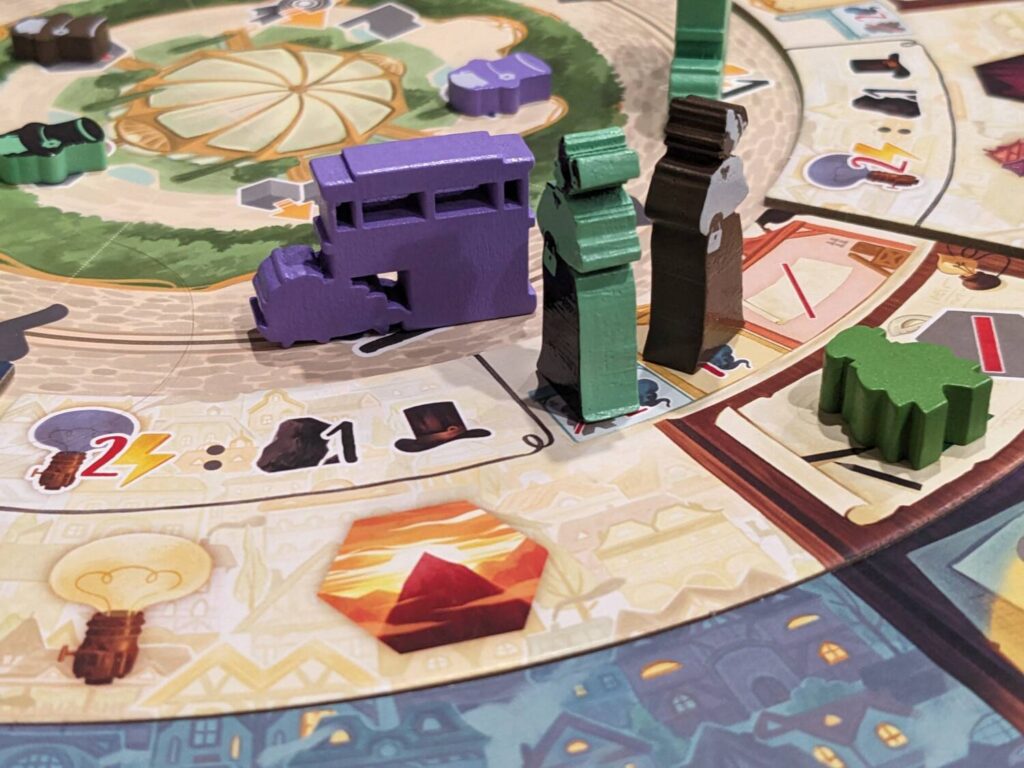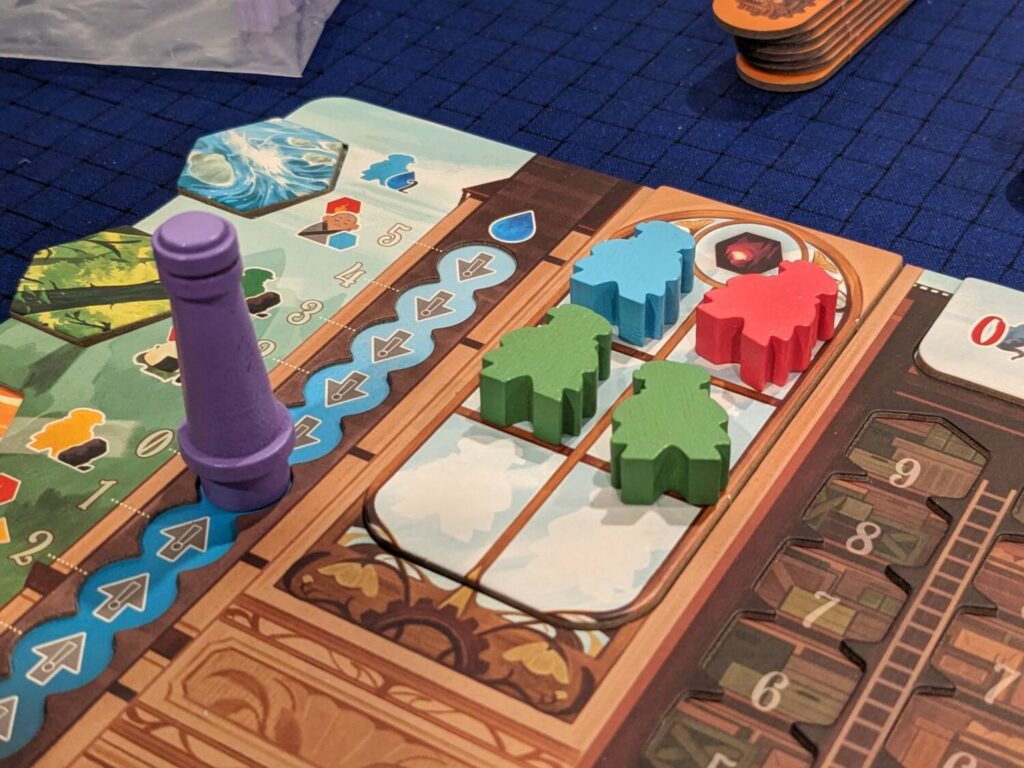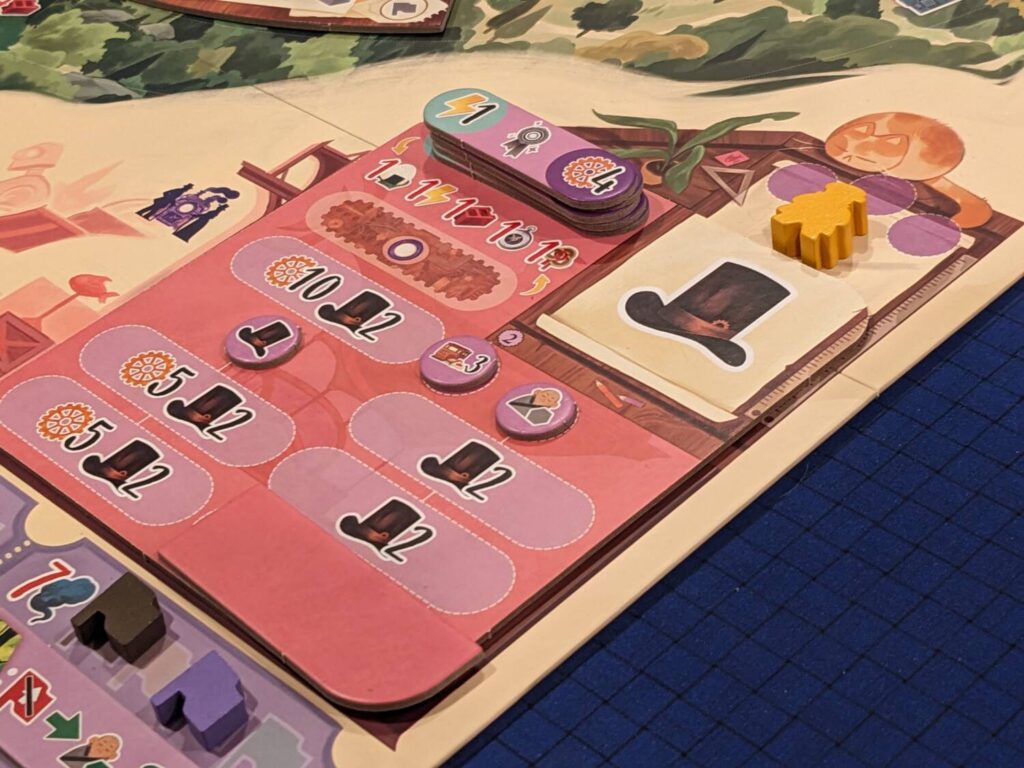Disclosure: Meeple Mountain received a free copy of this product in exchange for an honest, unbiased review. This review is not intended to be an endorsement.
Devir has had a year, my friends! Wrapping up a year of covering great games from the Portuguese publishing powerhouse, I had the chance to get one last Devir game to the table: Daitoshi.
Designed by Dani Garcia (Barcelona, Windmill Valley, Neko Syndicate), Daitoshi is the latest in the still-weird-to-me “Kemushi Saga” series of games. These loosely-connected games all have broad themes centered around the environment, silkworms, and a more peaceful, Euro-style approach to outracing opponents to each game’s victory conditions.
While I have had the chance to play a good chunk of the Kemushi games in the series—Sand, Bitoku, Bitoku: Resutoran, and Bamboo—I still don’t have a great feel for the connective tissue that the series seems to want to show off. No matter: the individual games have mostly been great, and Daitoshi is no exception.
Daitoshi has a decent amount of bloat—the game’s official teach video runs for a much-too-long 47 minutes—this for a game that has just five unique worker placement actions and only takes about two hours to play. But turns feel exceptionally fulfilling and the production is beautiful, right down to transportation tokens featuring a worm dragging a bus. (Yes, my friends. this is the first game I’ve ever played with “Worm-Bus” tokens.)
Daitoshi continues the hot streak that Garcia kicked off with his run of “point salad”-adjacent medium-to-heavy strategy games last year. While Daitoshi has four tracks too many and a rulebook that runs into the 30-page range, it’s an investment that I mostly enjoyed thanks to a host of “wow” moments and tension tied to managing the game’s Exploit action. It’s a big piece of environmentally-conscious chicken, and it won’t shock me if an expansion lands in my lap sooner than later.

Electrified
Daitoshi is a 1-4 player single worker placement game that features many of the creature comforts found in other great Euro games from 2024. You’ve got player boards with 13 different player tracks: eight to track inventions that power each player’s personal production engine, four to track spendable resources, and one to monitor your Steam Engine—four “Wilderness” tracks on the main board where players will score in four different end-game scoring categories, scores that reach into the mid-200 range, a Worm-Bus track that lets players gather resources and points, and a Reputation track that sports even better bonuses.
But Daitoshi is definitely not “Tracks: The Game”, like recent track-only enterprises such as Capstone’s 2023 release Rise. On a turn, players will usually move their single action pawn, known as their Magnate, to one of five action spaces. (A special shout-out to the production team for the Magnate tokens—players can choose from two different traditionally gendered pawns. More and more companies are getting better at offering players these sorts of minor but meaningful choices, and my hope is that in the next few years, more companies progress even further by offering more non-gendered, non-binary choices for playable characters.)
Turns in Daitoshi are complex, featuring a five-step process that tripped up all new players from time to time because there are so many things to remember. The game’s player aid is an exceptional iconography guide, as well as a useful tool when factoring in end-game scoring. But as a turn overview document, it is lacking, and players constantly needed help navigating each action space’s iconography and structure.
But once everyone has things down, Daitoshi really rounds into form. Players are tasked with building up the city in the center of the game’s oversized board by using building resources to expand outwards from a small central area. Players must power each new section of the board by taking the Electrify a District action, and they will occasionally need to spend the Luxury Goods resource to take the Trade with Other Cities action, which often provides a bevy of points and bonuses when taking other game actions.

Resources are tight, particularly early on, so players will eventually trigger the Production action a few times during the game. In Daitoshi, this action will activate each of the invention tiles on a player’s board, as long as there’s a blue checkmark above or below the invention tile. Daitoshi has a nice follow mechanic—if one player decides to produce, all players get at least a little something from their personal invention tracks, then even more bonuses if they have made improvements to their inventions by going up each invention’s individual track. (I know, I know. This game has a lot of tracks!)
This leads to one of my favorite parts of the Daitoshi design: mutual benefits.
Taking the production action benefits everyone, at least a little. Players who electrify a district set up other players to take advantage of better actions later, thanks to a step that allows players to use one-time-only workers to acquire bonuses in the district where their Magnate has just been placed. Expanding a district is a relief for the person who triggers that action, but that also creates more spaces for bonuses on another player’s turn.
Garcia detailed some of the thinking behind these shared/mutual benefits in a recent designer diary on BoardGameGeek, and I’m thankful the game features these elements. It’s a race, but it’s a race where players will constantly get a drip of goodies during the normal operations of gameplay.

Relief, You Say?
The main tension in Daitoshi comes from the management of Wilderness tiles, acquired each and every time a player takes the City (place their Magnate) action.
There are four Wilderness tracks on the board: river, mountains, forests, and underground. Each of the game’s actions requires a player to Exploit at least one hex, adding it to the left of their player board. This provides immediate benefits, in the form of steam (used to pay for some actions and movement around the map) and workers in one of four colors, used for warehouse actions at the start of a City turn.
But whenever a player takes a second Wilderness tile in a matching type to their player board, they begin to trigger negative effects at the end of that turn and all future turns when a player has 2+ tiles of the same category. These penalties are referred to as “Conflict with the Yokai”, and staying in check with these Yokai folks is a big reason why you will either enjoy or maybe not enjoy what Daitoshi is attempting to do here.
The forest tile penalty isn’t bad, you just earn less steam when moving markers up or down your Steam Engine track. You can probably survive that one.
But the river penalty is brutal. You can’t advance your invention tracks nearly as well as you can normally during a production round. The underground penalty might be the worst. Instead of holding six temporary workers, you can only hold two, and you never want to pass up adding as many workers as you can throughout play (bonuses, baby!).
Players are constantly trying to get Wilderness tiles off their player board. Some game effects remove them, such as taking the Expand a District action, moving up on various invention tracks or using warehouse actions. But for me, it was the sound players would make when they got to remove a Wilderness tile from their board—I got really good at letting out a loud sigh and sulking into my chair, temporarily relieved from the stress created by being in conflict.
And things get brutal fast if players can’t manage this process well. In my second three-player game, one opponent got to three river hex tiles and never dug out of that hole. As a result, he had a harder time advancing on his invention tracks, which scored fewer points and produced the least throughout the game.

An Enjoyable Load
There’s a lot going on in Daitoshi, and most of it works.
Typical for a Devir game, the production looks great, with player boards that feel deluxe and components that really stand out from anywhere at the table. The variety in the base game is enough for me. You have 20 different City tiles for use during the Trade with Other Cities action, four different Mega-Machine tiles that are used to provide a fifth action type along with special invention tiles, and a district structure that lays out a different map almost every time you will play.
Some of the combos in Daitoshi ended up being a blast, both as the one executing a combo and the one watching other players taking a satisfying turn. At three players, this worked well, but I think Daitoshi might overstay its welcome at four players. (I did two three-player games and one solo game for this review.) I really enjoyed how the production action worked here, in part because you can tell that you shouldn’t take more than 2-3 production turns in the entire game. You might be able to get away with doing it less if other players do it for you, but in some cases, you don’t want to produce to ensure your opponents don’t get a free pass when they are down on resources.

I don’t think the game needed scoring from four different Wilderness tracks, and it feels like a player can score points for doing just about anything…which meant there were lots of turns where players asked if someone else had accounted for the one point they got for a production here or two points for a Worm-Bus move there. Scores in Daitoshi ranged from the low 100s to the mid 200s in my games, but so much of that is a nickel here and a dime there. Everyone who joined me for a multiplayer game called Daitoshi a “point salad” for this reason. Some people think of that as a negative, others a positive, but it’s worth a callout because players score points for almost everything they do, all game long.
End-game scoring isn’t too involved, and the player aid is a great reminder of what tracks score which game functions, important as players shift their scoring focus during play.
I would recommend Daitoshi as a solo game only after playing the game with other people, but I still wouldn’t buy Daitoshi only for the solo mode. The automa system uses a deck of cards, and the actions on those cards make sense. The rules (six pages of the rulebook!) are involved but make sense as what a human player should prioritize. I found that there was so much upkeep for the solo bot that I would just rather play a two-player game…my solo play took about 75 minutes. That speaks well to the level of interaction in Daitoshi, but it’s too much to manage and felt like a chore by the end of my solo play.
As a multiplayer game with a couple friends who like a heavyweight strategy game, Daitoshi will stay in the collection. It won’t shock me in the slightest when Devir announces an expansion to the game next year, since the base system is pretty solid as-is and one could always use more district tiles and Mega-Machine actions to keep the enterprise fresh.
Devir does it again!












Add Comment